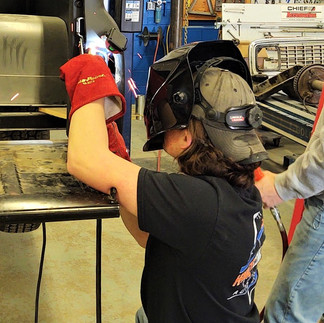C10 Body and Box Prep
- autocollision
- Mar 28, 2023
- 2 min read
Sheet metal, no matter whether it's located on a classic truck like the inTENse C10 or a newer vehicle, must have the proper preparation before any paint can be applied. Today's advanced corrosion resistance epoxy primers technology is applied using spray guns. But prep is still where everything has to begin and the C10 provides a great opportunity to experience all the various issues that can make a final coat a failure.
Most of the time getting metal prepared involves sanding the surface to remove all the paint and corrosion to begin the process of looking for surface defects. And because many vintage vehicle paints are not compatible with today's solvent based or water-based paints, it's extremely important to get all areas striped for the next step, the epoxy primer.

Cleaning the surface using various compounds and ordinary dirt removal methods is ongoing, even as sanding begins. The surrounding air will deposit dust and dirt particles continuously during prep and cleaning never stops.

Sanding the truck cab, front fenders, hood, and the truck box is time consuming, but it is essential to getting an excellent surface. So we use various sandpaper grits, constantly checking and rechecking surfaces for low spots and hammer and dolly them out so they are metal finished. The truck had several areas where corrosion was present and those needed attention, welding in metal as needed. All the molding holes had to be welded shut to make a clean smooth look. The same process is used to fit details like the openings for new tail light housings or smoothing some factory areas to better fit the modified design, as well as gapping the doors, hood, and tailgate to give that high end look.
Constant visual inspection is needed before an epoxy primer is applied, which not only seals the surface from contaminants in the air, but provides a corrosion resistance layer that will allow Hawkeye students to start their bodywork using Linear Blocks and 3M body filler.

The students will spend lots of time inspecting prepped areas, noting changes as the primer coat dries and imperfections become visible. Some areas, particularly on older vehicle surfaces, can require extended prep time, and we are seeing plenty of that process.
















Speed Stars captures the pure adrenaline rush of sprinting from zero to maximum speed, and that simplicity is exactly what makes it so addictive. Every run becomes a battle between precision, timing, and your reflexes
One wrong move and ragdoll archers might send your archer flailing across the battlefield before you even get to shoot
geometry dash endless customization and user-generated content make it feel like a game that never truly ends.
It’s amazing how much effort goes into getting metal surfaces ready, from sanding to welding to filling low spots. The focus on detail and checking your work over and over again is crucial. Reading this actually reminded me of playing Geometry Dash—sometimes you have to go over a level multiple times to perfect each move, just like prepping a truck requires repeated attention to every surface before primer.
Each drift feels rewarding when pulled off correctly. Collectible coins and unlockable cars provide long-term motivation, while the endless nature of Drift Boss game ensures it never feels repetitive.